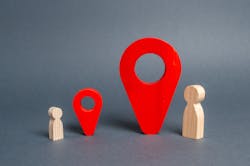For healthcare businesses, boosting wellness and promoting comfort is part of the job. But healthcare also comes with its share of liabilities and uncertainties: walking into the rooms of patients who are unwell, may be experiencing mental distress, may have aggressive reactions to medications, or hold hostility towards treatment means having to be prepared for any scenario. To meet this need, healthcare facilities are employing the latest safety solutions to protect and empower employees in any situation. One of these solutions is leveraging location technology.
Location technology promotes safety for both staff and patients, boosting transparency by tracking locations and increasing accountability while decreasing unpredictability. Location technology powers a variety of different solutions to help staff and patients to react to different scenarios. All told, location technology creates a safer environment, mitigates risk, builds accountability, and increases staff morale.
Safety First
What do these solutions look like in practice? There are several different solutions available for various needs. Top solutions on the market include:
● Staff duress — Portable devices, either tags or pendants, that alert selected officials of problems or danger for immediate action.
● Panic buttons — Buttons fixed to a certain location that alert selected officials of problems or danger for immediate action.
● Security controllers — Sensors that limit access to locations within a healthcare facility.
● Patient safety and wander management — Tracking solutions that keep patients from wandering off-premise or to an unsafe location.
● Man-down solutions — Staff members are alerted to patient or staff member falls as soon as they happen.
Each solution boosts staff and patient wellness and is optimized for immediacy. Location data can provide pinpoint accuracy that eliminates time wasted searching for the location of the problem, allowing it to be resolved more quickly. And since most technologies in this segment require certain mission-critical characteristics, these solutions have built-in redundancy or acknowledgment/verification of received alarm conditions as well as multiple methods of annunciating or broadcasting alarm conditions. This ensures that in the event of an emergency, there is always a response to a call and that it’s responded to as quickly as possible.
These location technology solutions tout many benefits for both people and the business: providing a safer environment for patients and staff while building accountability and mitigating risk for the organization.
Power to the People
Healthcare businesses with location technology find themselves boosting not only safety (though that is the main objective) but staff morale as well. For staff, having help at the touch of a button creates peace of mind, and ensures support in any scenario. This empowers staff to take control of situations and to request help if needed.
For patients, location technology can provide two different benefits: keeping them in secured areas when their health is compromised and providing emergency buttons when they need help. Keeping patients in secure areas can mean keeping a baby in a maternity ward or a memory care patient in a senior living facility. The transmitters on the body of the person react to the sensors by the door and activate locks or alarms to prevent the breach.
Patients also have access to panic buttons in the same manner that staff members do. The action provides the name and location of the originating individual to the caregivers. Most of these types of systems provide ample flexibility to accommodate different scenarios and site-specific requirements, empowering the healthcare facility to tailor the solution to their needs.
Win-Win
Healthcare businesses also benefit from empowering patients and employees, as location technology provides immediate notifications that can prevent escalations and incidents altogether. The visual of the solution itself, in addition to any alarms that sound as a result of it being activated, can also serve to deescalate situations and avoid them in the future.
The data serves a long-term purpose as well, with this information creating real-time reactions from the system such as sounding alarms as well as storage and archiving of the data for future reporting and analysis. Having a record of incidents also leads to long-term strategies that can help eliminate them in the future, drawing from detailed information that helps in proactive risk strategies.
Mitigating risk in this way not only promotes safety across the business but also helps prevent financial and incidental liabilities.
A Versatile Solution
Using a location technology solution increases the possibility of data usage across the facility. Integrating the solution can create adjacent benefits, as data can power other initiatives within the business. Although the core function of the system is its life-safety features to initiate an alert about an incident, the locating of this technology platform can be used to provide data to many third-party systems, allowing for improved operational workflow, decrease human error while improving staff efficiency and productivity and driving automated decision-making. For those looking for increasing safety, empowerment, morale, and wellbeing across their healthcare facility, location technology is an amazing channel to increase all the above.
About the Author: Mohsen Hekmatyar is the Vice President of Sales, Security Solutions with CenTrak, the market leader in Enterprise Locating and Sensing Services™.


